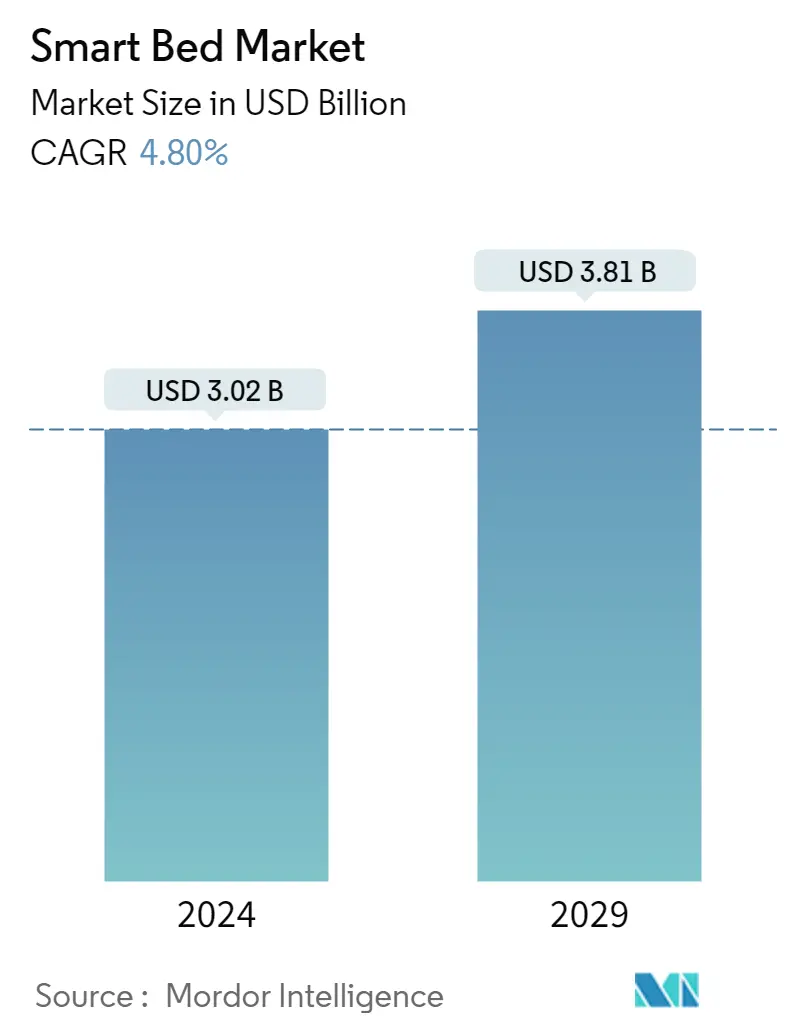Market Size of Smart Bed Industry

| Study Period | 2020 - 2029 |
| Market Size (2024) | USD 3.02 Billion |
| Market Size (2029) | USD 3.81 Billion |
| CAGR (2024 - 2029) | 4.80 % |
| Fastest Growing Market | Asia Pacific |
| Largest Market | North America |
Major Players
*Disclaimer: Major Players sorted in no particular order |
Smart Bed Market Analysis
The Smart Bed Market size is estimated at USD 3.02 billion in 2024, and is expected to reach USD 3.81 billion by 2029, growing at a CAGR of 4.80% during the forecast period (2024-2029).
COVID-19 has had an exceptional and catastrophic worldwide impact, with smart bed products having a beneficial influence across all regions during the epidemic.
Smart beds are available for residential and commercial purposes, with a range of features that can enhance the user experience in ways not possible otherwise. The demand for a higher level of comfort from the developed areas is driving the market studied. Smart beds meet such demand by helping users sleep better.
The rising adoption of smart beds in the healthcare sector is impelling the growth of the smart bed market, as they offer benefits, such as enhanced and intensive care of patients in hospitals and health benefits for residential consumers. New entrants can have a glimpse of the advancements in this emerging market. The semi-automatic type segment is leveraging the growth of the market.
The growing young population and rise in disposable income are mainly driving the growth of the market. However, a lack of expertise in manufacturing smart beds in various regions is a drawback for market growth. The low availability of these beds in the stores and lower production rates restrain the market growth.
Smart Bed Industry Segmentation
A complete background analysis of the smart bed market, which includes an assessment of the parental market, emerging trends by segments and regional markets, and significant changes in market dynamics and market overview, is covered in the report. The report also features qualitative and quantitative assessments by analyzing the data gathered from industry analysts and market participants across key points in the industry's value chain. The Smart Bed Market is Segmented by Product (Manual, Semi-automatic, and Fully-automatic), by End User (Residential, Hospital, and Other End Users), by Distribution Channel (Supermarkets/Hypermarkets, Specialty Stores, Online, and Other Distribution Channels), and by Geography (North America, Europe, Asia-Pacific, South America, and Middle-East and Africa).
| By Product | |
| Manual | |
| Semi-automatic | |
| Fully -automatic |
| By End User | |
| Residential | |
| Hospital | |
| Other End Users |
| By Distribution Channel | |
| Supermarkets/Hypermarkets | |
| Specialty Stores | |
| Online | |
| Other Distribution Channels |
| Geography | |
| North America | |
| Europe | |
| Asia-Pacific | |
| South America | |
| Middle-East and Africa |
Smart Bed Market Size Summary
The smart bed market is poised for significant growth, driven by increasing demand for enhanced comfort and advanced healthcare solutions. These beds, designed for both residential and commercial use, offer features that improve user experience and sleep quality. The healthcare sector, in particular, is a major contributor to market expansion, as smart beds provide intensive care and health benefits, improving patient management and recovery. The market is also benefiting from a growing young population and rising disposable incomes, although challenges such as manufacturing expertise and limited availability in stores may hinder growth. Technological advancements and government investments in healthcare are expected to further propel the market, with smart beds increasingly integrated with cardio monitoring sensors to address cardiovascular disorders.
Regionally, Asia Pacific is anticipated to experience the fastest growth, fueled by rapid urbanization and digital transformation in countries like China, Japan, and South Korea. These nations are at the forefront of technology-driven trends, boosting demand for smart beds and related home automation products. The market is dominated by major players such as Paramount Bed Co., Stryker Corporation, and Hill Rom Holdings Inc., but mid-size and smaller companies are gaining traction through technological innovations and new market contracts. Recent advancements in smart bed features, including sleep tracking, climate control, and IoT connectivity, are enhancing market appeal and driving adoption across various sectors.
Smart Bed Market Size - Table of Contents
-
1. MARKET DYNAMICS
-
1.1 Market Overview
-
1.2 Market Drivers
-
1.3 Market Restraints
-
1.4 Industry Value Chain Analysis
-
1.5 Porter's Five Forces Analysis
-
1.5.1 Threat of New Entrants
-
1.5.2 Bargaining Power of Buyers
-
1.5.3 Bargaining Power of Suppliers
-
1.5.4 Threat of Substitutes
-
1.5.5 Intensity of Competitive Rivalry
-
-
1.6 Trends Shaping the Smart Bed Market
-
1.7 Technological Innovations in the Market
-
1.8 Impact of COVID-19 on the Market
-
-
2. MARKET SEGMENTATION
-
2.1 By Product
-
2.1.1 Manual
-
2.1.2 Semi-automatic
-
2.1.3 Fully -automatic
-
-
2.2 By End User
-
2.2.1 Residential
-
2.2.2 Hospital
-
2.2.3 Other End Users
-
-
2.3 By Distribution Channel
-
2.3.1 Supermarkets/Hypermarkets
-
2.3.2 Specialty Stores
-
2.3.3 Online
-
2.3.4 Other Distribution Channels
-
-
2.4 Geography
-
2.4.1 North America
-
2.4.2 Europe
-
2.4.3 Asia-Pacific
-
2.4.4 South America
-
2.4.5 Middle-East and Africa
-
-
Smart Bed Market Size FAQs
How big is the Smart Bed Market?
The Smart Bed Market size is expected to reach USD 3.02 billion in 2024 and grow at a CAGR of 4.80% to reach USD 3.81 billion by 2029.
What is the current Smart Bed Market size?
In 2024, the Smart Bed Market size is expected to reach USD 3.02 billion.

